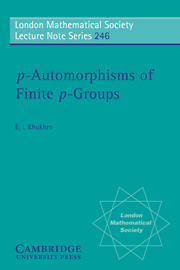Book contents
- Frontmatter
- Contents
- Preface
- Introduction
- Chapter 1 Preliminaries
- Chapter 2 Automorphisms and their fixed points
- Chapter 3 Nilpotent and soluble groups
- Chapter 4 Finite p-groups
- Chapter 5 Lie rings
- Chapter 6 Associated Lie rings
- Chapter 7 Regular automorphisms of Lie rings
- Chapter 8 Almost regular automorphism of order p: almost nilpotency of p-bounded class
- Chapter 9 The Baker–Hausdorff Formula and nilpotent ℚ-powered groups
- Chapter 10 The correspondences of A. I. Mal'cev and M. Lazard
- Chapter 11 Powerful p-groups
- Chapter 12 Almost regular automorphism of order pn: almost solubility of pn-bounded derived length
- Chapter 13 p-Automorphisms with p fixed points
- Chapter 14 Automorphism of order p with pm fixed points: almost nilpotency of m-bounded class
- Bibliography
- Index of names
- Subject Index
- List of symbols
Chapter 7 - Regular automorphisms of Lie rings
Published online by Cambridge University Press: 22 October 2009
- Frontmatter
- Contents
- Preface
- Introduction
- Chapter 1 Preliminaries
- Chapter 2 Automorphisms and their fixed points
- Chapter 3 Nilpotent and soluble groups
- Chapter 4 Finite p-groups
- Chapter 5 Lie rings
- Chapter 6 Associated Lie rings
- Chapter 7 Regular automorphisms of Lie rings
- Chapter 8 Almost regular automorphism of order p: almost nilpotency of p-bounded class
- Chapter 9 The Baker–Hausdorff Formula and nilpotent ℚ-powered groups
- Chapter 10 The correspondences of A. I. Mal'cev and M. Lazard
- Chapter 11 Powerful p-groups
- Chapter 12 Almost regular automorphism of order pn: almost solubility of pn-bounded derived length
- Chapter 13 p-Automorphisms with p fixed points
- Chapter 14 Automorphism of order p with pm fixed points: almost nilpotency of m-bounded class
- Bibliography
- Index of names
- Subject Index
- List of symbols
Summary
The theorems of G.Higman, V. A.Kreknin and A. I. Kostrikin on regular automorphisms of Lie rings can be viewed as combinatorial facts about (Z/nZ)- graded Lie rings: they are actually proved as such, and it is in this form that they are used in studying p-automorphisms of nilpotent p-groups. We shall first prove Kreknin's Theorem for graded Lie rings using the varietal criterion from §5.2, which simplifies the proof to a few lines. (A longer version which gives an explicit upper bound for the derived length is indicated in the exercises.) Then nilpotency is derived from solubility in the case of the automorphism of prime order, again for graded Lie rings. Free Lie rings allow us to derive the required combinatorial consequences for arbitrary Lie rings. The theorems on Lie rings and finite nilpotent groups with regular automorphisms are also obtained as corollaries of these combinatorial facts.
Graded Lie rings
For the definition of graded Lie rings, see § 5.1. We begin with a version of a theorem of V. A. Kreknin [1963].
Theorem 7.1.Let n be a positive integer and suppose that L = L0 ⊕ L1 ⊕ … ⊕ Ln–1 is a (ℤ/nℤ)-graded Lie ring with components Ls satisfying [Li, Lj] ⊆ Li+j, where i + j is a residue mod n. If L0 = 0, then L is soluble of n-bounded derived length: L(k(n)) = 0 for some function k(n) depending only on n.
Information
- Type
- Chapter
- Information
- p-Automorphisms of Finite p-Groups , pp. 83 - 94Publisher: Cambridge University PressPrint publication year: 1998
